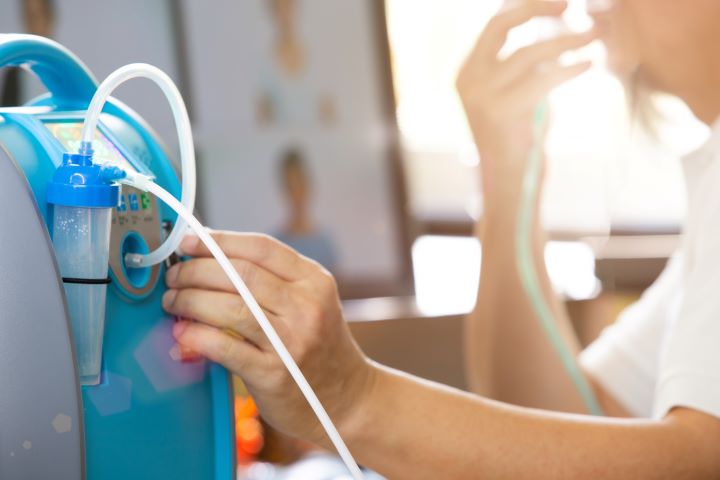Portable Oxygen Machines: A Breath of Fresh Air for Mobility and Health
Portable oxygen machines, also known as portable oxygen concentrators, have revolutionized the way individuals with respiratory conditions manage their oxygen therapy. These compact devices offer a convenient and efficient solution for those who require supplemental oxygen, allowing them to maintain their independence and quality of life. As medical technology continues to advance, portable oxygen machines have become increasingly popular among patients and healthcare providers alike.

The concentrated oxygen is then delivered to the user through a nasal cannula or mask, providing a continuous flow of oxygen or delivering it in pulses synchronized with the user’s breathing pattern. This technology allows for a more efficient and compact design compared to traditional oxygen tanks, making portable oxygen machines an ideal solution for individuals who require oxygen therapy on the go.
What are the benefits of using a portable oxygen concentrator?
Portable oxygen concentrators offer numerous advantages over traditional oxygen delivery methods, making them an attractive option for many patients:
-
Improved mobility: The compact size and lightweight design of portable oxygen machines allow users to move freely and maintain an active lifestyle.
-
Increased independence: Users can travel more easily, participate in social activities, and run errands without being tethered to bulky oxygen tanks.
-
Enhanced safety: Unlike compressed oxygen tanks, portable concentrators do not pose a risk of explosion or leakage, making them safer for use in various environments.
-
Continuous oxygen supply: These devices can operate for extended periods, providing a reliable source of oxygen without the need for frequent refills or tank replacements.
-
Cost-effective in the long run: While the initial investment may be higher, portable oxygen concentrators can be more economical over time compared to recurring costs associated with oxygen tank rentals or refills.
-
Improved quality of life: By enabling users to maintain their daily routines and activities, portable oxygen machines can significantly enhance overall well-being and mental health.
Who can benefit from using a portable oxygen machine?
Portable oxygen machines are suitable for a wide range of individuals who require supplemental oxygen therapy, including:
-
Patients with chronic obstructive pulmonary disease (COPD)
-
Individuals with emphysema or chronic bronchitis
-
People with cystic fibrosis
-
Those suffering from pulmonary fibrosis
-
Individuals with sleep apnea who require oxygen therapy
-
Patients recovering from severe respiratory infections or COVID-19
-
Individuals with heart conditions that affect oxygen levels
-
Those living at high altitudes who may experience difficulty breathing
It’s important to note that the use of a portable oxygen machine should always be prescribed and monitored by a healthcare professional to ensure proper usage and optimal therapy outcomes.
What features should you consider when choosing a portable oxygen concentrator?
When selecting a portable oxygen concentrator, several key features should be taken into account:
-
Weight and size: Consider the device’s portability and how easily it can be carried or transported.
-
Battery life: Look for machines with long-lasting batteries or the option to use additional battery packs for extended use.
-
Oxygen flow rate: Ensure the device can deliver the prescribed oxygen flow rate, whether continuous or pulse-dose.
-
Noise level: Some machines operate more quietly than others, which can be important for comfort and discretion.
-
Durability: Look for devices built to withstand daily use and potential impacts during travel.
-
FAA approval: If air travel is a consideration, choose a model approved for use on airplanes.
-
Maintenance requirements: Consider the ease of cleaning and any regular maintenance needed to keep the device in optimal condition.
-
User interface: Opt for a machine with intuitive controls and clear display for ease of use.
How much do portable oxygen machines cost, and are they covered by insurance?
The cost of portable oxygen machines can vary significantly depending on the brand, features, and specifications. Generally, prices range from $2,000 to $6,000 for high-quality, reliable models. However, it’s important to consider the long-term cost savings compared to recurring expenses associated with traditional oxygen tanks.
| Brand | Model | Estimated Price Range |
|---|---|---|
| Inogen | One G5 | $2,400 - $3,000 |
| Philips Respironics | SimplyGo Mini | $2,300 - $2,800 |
| ResMed | Mobi | $2,500 - $3,100 |
| CAIRE | FreeStyle Comfort | $2,700 - $3,300 |
| Invacare | Platinum Mobile | $2,200 - $2,700 |
Prices, rates, or cost estimates mentioned in this article are based on the latest available information but may change over time. Independent research is advised before making financial decisions.
Many insurance plans, including Medicare, may cover the cost of portable oxygen machines if they are deemed medically necessary. However, coverage can vary depending on the specific plan and the patient’s medical condition. It’s advisable to check with your insurance provider to understand your coverage options and any out-of-pocket expenses you may incur.
Some suppliers offer rental options or financing plans to make portable oxygen machines more accessible to those who may not have full insurance coverage or prefer not to purchase the device outright.
In conclusion, portable oxygen machines have transformed the landscape of oxygen therapy, offering users greater freedom, convenience, and quality of life. By understanding the benefits, features, and costs associated with these devices, individuals can make informed decisions about incorporating portable oxygen concentrators into their healthcare regimen. As always, it’s crucial to consult with a healthcare professional to determine the most appropriate oxygen therapy solution for your specific needs.
This article is for informational purposes only and should not be considered medical advice. Please consult a qualified healthcare professional for personalized guidance and treatment.





